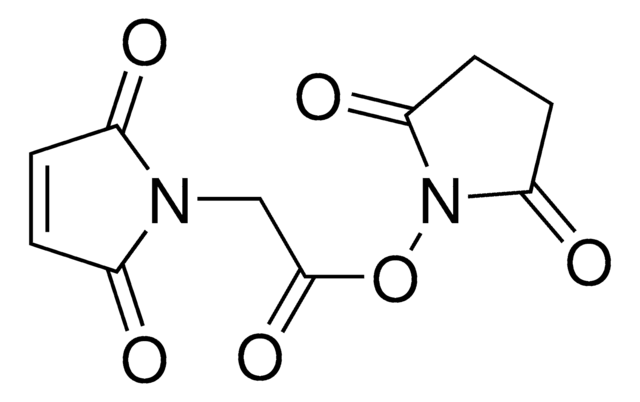803618
DTME (dithio-bis-maleimidoethane)
Synonyme(s) :
1,1′-(dithiodi-2,1-ethanediyl)bis-1H-Pyrrole-2,5-dione, 1-[2-[[2-(2,5-Dihydro-2,5-dioxo-1H-pyrrol-1-yl)ethyl]dithio]ethyl]-1H-pyrrole-2,5-dione, DTME
About This Item
Produits recommandés
Essai
≥90%
Forme
powder
Poids mol.
312.37
Pertinence de la réaction
reagent type: cross-linking reagent
Conditions de stockage
desiccated
Solubilité
DMSO or DMF: soluble
Conditions d'expédition
ambient
Température de stockage
2-8°C
Chaîne SMILES
O=C(C=CC1=O)N1CCSSCCN2C(C=CC2=O)=O
InChI
1S/C12H12N2O4S2/c15-9-1-2-10(16)13(9)5-7-19-20-8-6-14-11(17)3-4-12(14)18/h1-4H,5-8H2
Clé InChI
SGVWDRVQIYUSRA-UHFFFAOYSA-N
Description générale
Caractéristiques et avantages
- Reactive groups: maleimide (both ends)
- Reactive towards: sulfhydryl groups
- Long (13.3A), cleavable, sulfhydryl-to-sulfhydryl crosslinker, composed of maleimide groups and 11-atom disulfide spacer arm
- Water-insoluble—dissolve first in DMF or DMSO, then add to aqueous reaction buffers
- Cleavable by reduction of disulfide spacer arm with DTT, TCEP or other reducing agent
Attention
Mention d'avertissement
Warning
Mentions de danger
Classification des risques
Acute Tox. 4 Dermal - Acute Tox. 4 Inhalation - Acute Tox. 4 Oral - Eye Irrit. 2 - Skin Irrit. 2 - STOT SE 3
Organes cibles
Respiratory system
Code de la classe de stockage
11 - Combustible Solids
Classe de danger pour l'eau (WGK)
WGK 3
Point d'éclair (°F)
Not applicable
Point d'éclair (°C)
Not applicable
Faites votre choix parmi les versions les plus récentes :
Certificats d'analyse (COA)
It looks like we've run into a problem, but you can still download Certificates of Analysis from our Documents section.
Si vous avez besoin d'assistance, veuillez contacter Service Clients
Déjà en possession de ce produit ?
Retrouvez la documentation relative aux produits que vous avez récemment achetés dans la Bibliothèque de documents.
Les clients ont également consulté
Active Filters
Notre équipe de scientifiques dispose d'une expérience dans tous les secteurs de la recherche, notamment en sciences de la vie, science des matériaux, synthèse chimique, chromatographie, analyse et dans de nombreux autres domaines..
Contacter notre Service technique










